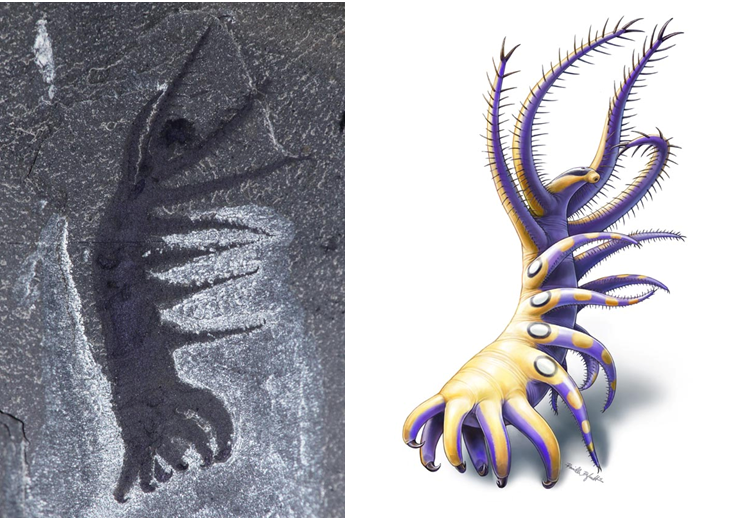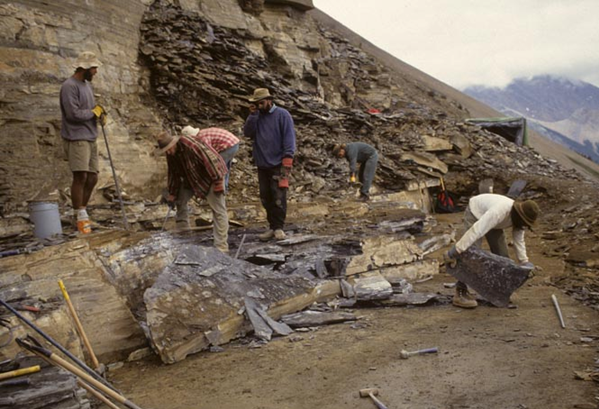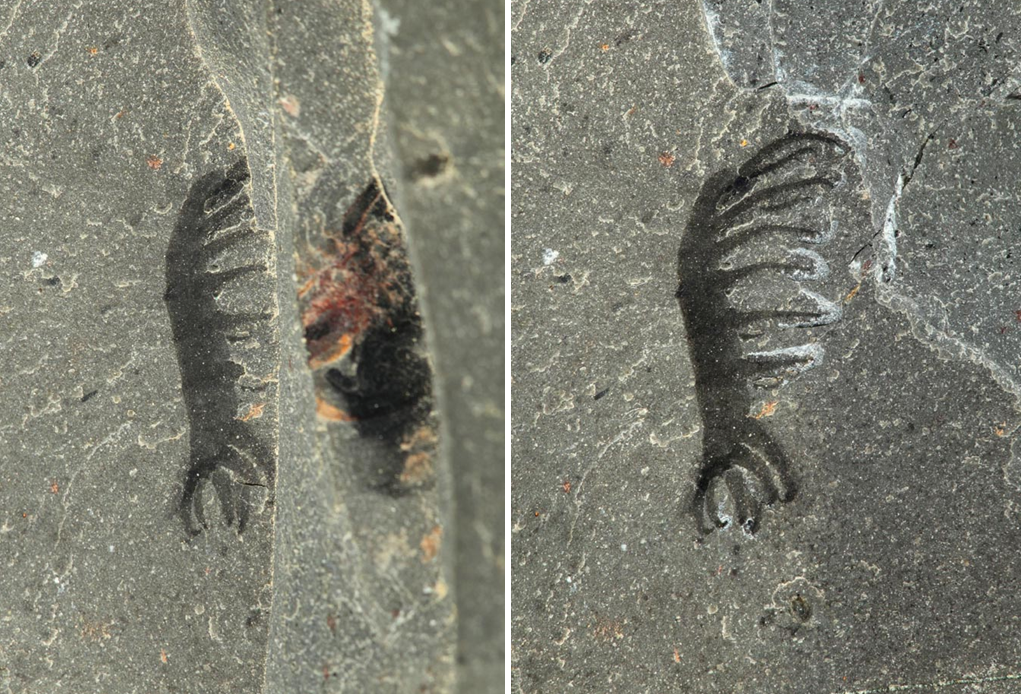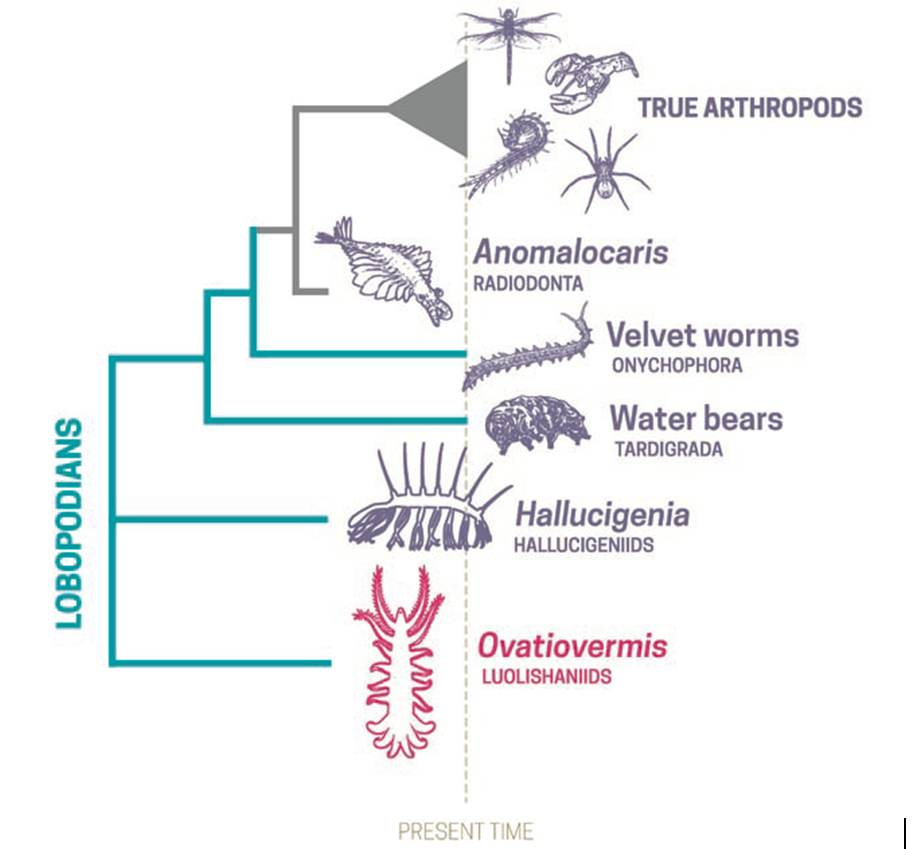Three cheers for Burgess Shale’ newest oddball animal, a worm with waving “arms”
By Jean-Bernard Caron, Senior Curator of Invertebrate Palaeontology, Royal Ontario Museum
Today, the ROM is announcing a spectacular new species from the world-famous Burgess Shale site in Yoho National Park. Its name, Ovatiovermis cribratus, means “standing suspension-feeding worm” in Latin to reflect the worm’s posture in life. Ovatiovermis cribratus is one of the most beautiful Burgess Shale animals that I have had the pleasure to study. It is a real privilege to be able to formally describe this fantastic new creature, known originally from a single specimen which had been in our collections for some time. The Burgess Shale is well known already for bizarre looking animals, but this new species is certainly one of the oddest! Our study appears in the open (free) access journal BMC Evolutionary Biology*.
*Full reference of the paper: Caron, Jean-Bernard, and Aria, Cédric. Cambrian suspension-feeding lobopodians and the early radiation of panarthropods. BMC Evolutionary Biology. January 31st, 2017. http://rdcu.be/oWnB
The new species in a snapshot
The specimen is shorter than my thumb even with its limbs fully extended — 3 cm to be exact. It has a soft, stubby worm-like body with a tiny head and nine pairs of limbs. The first two pairs of limbs, just behind the head, are the longest, and are equipped with elongate spines so that they look like combs. The last three pairs of limbs are very different. They are stouter, curved inward, and each one bears a single strong claw at the end. The head bears two tiny eyes on top, and the mouth, at the very front, is armed with tiny teeth.

Life and feeding habits
The animal likely used its three pairs of posterior limbs to anchor itself on the sea bottom and its frontalmost limbs to sieve food items from the water in a way similar to how some modern skeleton shrimps do today. We can only speculate about its diet because we don’t have hard evidence of what it ate, but, based on the distance between the spines along its limbs, usually around 0.3 mm, this animal probably ate tiny creatures called zooplankton, that is, mainly the larval stages of many different kinds of invertebrates.
The origins of the two ROM specimens
Ovatiovermis comes from the Walcott Quarry, part of the Burgess Shale fossil deposit, in Yoho
National Park, British Columbia, Canada. This site is famous for its preservation of a rich marine biota dating back to the Cambrian period. This new lobopodian species is an extremely rare fossil, considering that only two specimens were recovered out of a quarter million Burgess Shale fossil specimens known in museum collections, most of which are at the Royal Ontario Museum.
The first specimen — which we designated in our paper as the main type specimen, or holotype — is the best preserved. Dr. Desmond Collins, my predecessor at the Royal Ontario Museum, collected it in 1994 by while excavating new fossil layers below the floor of the Walcott Quarry.

I started working on this extraordinary specimen a few years ago with my co-author Cédric Aria, as part of his doctoral work at the University of Toronto. During the summer of 2016 and just a few months after having sent the paper for review, I went to visit the Burgess Shale to do some field work. Parks Canada, the agency that manages the Burgess Shale, showed me a few fossils that had been discovered in talus piles by visitors in the past few years while on guided hikes to the Walcott Quarry. I vividly remember that my jaw dropped at the sight of one of those specimens in particular, which, at the time, was thought possibly to be a kind of claw of some sort of arthropod, but the Burgess Shale Geoscience guide who led the trip a the time was puzzled by it, so Parks Canada kept the fossil to be observed by scientists like me at a later date. I am so glad this specimen was not discarded at the time of its discovery! I clearly recognised it as the same species of animal that we had just studied in detail for the past few years! I obviously got very excited, and after careful preparation and photography back at the Royal Ontario Museum, the specimen was eventually integrated into our paper. This second specimen nicely confirmed our interpretations of the morphology of the animal. Serendipity can sometimes help researchers in strange ways! The visitor who found that second specimen was certainly very, very lucky! What are the odds of finding such a rare animal on a casual guided hike, while teams of researchers over the past 100 years found only a single specimen during extensive quarrying operations? This story certainly underscores that we are still far from knowing everything about the Burgess Shale and they are still many discoveries to be made!

What this new species tells us about early animal evolution
This new species belongs to an extinct group of marine invertebrates with soft limbs, the lobopodians, comprising 30 or so fossil species, mostly from the Cambrian era, and from many deposits across the world. Lobopodians are thought to have given rise to the largest group of living animals today, the arthropods, and two related, but much smaller groups, the velvet worms (onychophorans) and the water bears (tardigrades). Lobopodians evolved during the so-called Cambrian explosion, an extraordinary time when the first recognizable animals appeared in the fossil record and underwent rapid evolution into all the major animal groups that we still know today. Because fossilized remains of those organisms are so rare, the ecology of lobopodians and their relationships to animals alive now are still being debated and are dependent on new fossil discoveries. This new form is only the third species of lobopodian to be described from the original Burgess Shale discovery site, with the two other forms (Hallucigenia and Aysheaia) first reported in 1911 by Charles Walcott, the discoverer of the Burgess Shale, 106 years earlier!

Although rare, this new species is so well preserved, and the specimens show so many details of its anatomy, that we were able to not only infer its ecology, but also to re-evaluate the relationships and ecology of a large number of lobopodian forms. We found that, like Ovatiovermis, many other lobopodians were likely suspension feeders that sieved the water for particles of plankton, a lifestyle which would then have been much more widespread during the Cambrian period than previously thought. When trying to place Ovatiovermis and its relatives in the tree of life, it turned out that previous interpretations of the relationships of lobopodians did not hold up well against the new evidence, and that suspension-feeding lobopodians were much closer to ancestral worm-like animals than previously suggested by some authors. After we analyzed a large dataset of body characteristics, we found that these lobopodians formed two separate groups, probably each with its own strategies for suspension feeding. It is from these groups that other lobopodians, tardigrades, onychophorans and the most successful group of animals, the arthropods, have likely emerged. All these animals may therefore all share an ancestor that was sieving particles of food from the water.
It’s naked!
We know that some of the closest lobopodians relatives evolved defensive armour, such as spines, as in Hallucigenia (see the ROM blog on our latest research), which is generally thought to have evolved in response to increase in predation pressure during the Cambrian. The new form is “naked” in the sense that it does not have spines or plates on its body. Instead, it has a smooth skin, prompting us to wonder how this animal was able to fend for itself against large predators, which we know were living in the same environment. This animal, anchoring itself with its back legs and slowly waving its feeding arms in the water, would have been extremely vulnerable to agile swimming animals — for example, Anomalocaris. While we don’t have clear answers, we speculate in our paper that Ovatiovermis might have had defensive coloration and/or been poisonous enough to have dissuaded would-be predators from taking a bite.
Why did this animal fossilize?
Ovatiovermis would have been buried very quickly in an undersea mudflow event, like all the other Burgess Shale animals, before being compressed flat during the fossilization process. However, the reason why this animal and others preserved at the same time and place did not decay afterwards remains an area of great uncertainty and continuous research. It is likely that specific water chemistry conditions, mainly present during the Cambrian, might be one of the reasons for the exceptional preservation of soft tissues that otherwise would have decayed.
Take home message
Our understanding of the origin and evolution of animals critically depends on exceptionally well-preserved fossil specimens, like the ones described in this study. Without such fossils, we would have very limited ideas about the morphology and diversity of the animals that lived on our planet in the past. This study also underscores the fact that, despite being known to palaeontology for more than 100, years the Burgess Shale continues to yield new species. The Royal Ontario Museum has been collecting fossils from the Burgess Shale and nearby areas since 1975 in partnership with Parks Canada, and with more work in the field, new Burgess Shale sites continue to be found, with treasure troves of new species to describe, suggesting that we have only scratched the surface of what the diversity of Cambrian ecosystems might have looked like.
See Ovatiovermis at the ROM
You can see one of the two specimens at the basis of this new study at the ROM in the research case within the Dawn of Life Preview Gallery on the 2nd floor, just next to the Rotunda. Learn more about the preview gallery and the Dawn of Life Gallery project.
